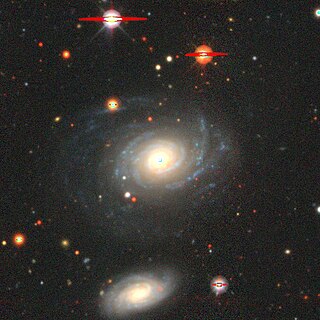
NGC 1 is an intermediate spiral galaxy of the morphological type Sbc, located in the constellation of Pegasus. It was discovered on 30 September 1861 by Heinrich d'Arrest.

NGC 3 is a lenticular galaxy with the morphological type of S0, located in the constellation of Pisces. Other sources classify NGC 3 as a barred spiral galaxy as a type of SBa. It was discovered on November 29, 1864, by Albert Marth.

NGC 70 is a spiral galaxy located in the constellation Andromeda. It was discovered on October 7, 1855, by R. J. Mitchell and was also observed on December 19, 1897 by Guillaume Bigourdan from France who described it as "extremely faint, very small, round, between 2 faint stars".

NGC 354 is a barred spiral galaxy in the constellation Pisces. It was discovered on October 24, 1881 by Édouard Stephan. It was described by Dreyer as "very faint, very small, round, very small (faint) star involved, 14th magnitude star close to west."

NGC 364 is a barred lenticular galaxy in the constellation Cetus. It was discovered on September 2, 1864, by Albert Marth. It was described by Dreyer as "very faint, very small."
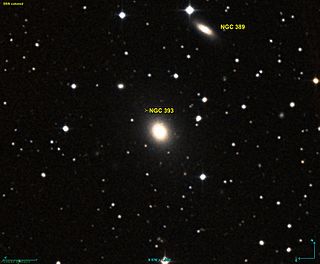
NGC 393 is a lenticular galaxy located in the constellation Andromeda. It was discovered on October 5, 1784, by William Herschel. It was described by Dreyer as "faint, very small, very little extended, gradually brighter middle, four small (faint) stars near."

NGC 397 is a lenticular galaxy located in the constellation Pisces. It was discovered on December 6, 1866, by Robert Ball. It was described by Dreyer as "extremely faint, small, round, very faint star to west."

NGC 409 is an elliptical galaxy located in the constellation Sculptor. It was discovered on November 29, 1837 by John Herschel. It was described by Dreyer as "extremely faint, small, round, very small (faint) star near."

NGC 422 is an open cluster located in the constellation Tucana. It was discovered on September 21, 1835, by John Herschel. It was described by John Louis Emil Dreyer as "very faint ", with Nubecular Minor being the Small Magellanic Cloud. It was also described by DeLisle Stewart as "only 3 extremely faint stars, close together, not a nebula."

NGC 449 is a spiral galaxy of type (R')S? located in the constellation Pisces. It was discovered on November 11, 1881 by Édouard Stephan. It was described by Dreyer as "very faint, very small, round, very little brighter middle, very faint star involved."

NGC 460 is an open cluster with nebula located in the constellation Tucana. It was possibly observed on August 1, 1826, by James Dunlop, although it was officially discovered on April 11, 1834, by John Herschel. It was described by Dreyer as "very faint .", with Nubecular Minor being the Small Magellanic Cloud. It was also described by DeLisle Stewart as "faint, pretty large, irregularly round, gradually brighter middle, mottled but not resolved, 2nd of several."
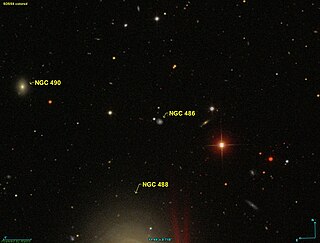
NGC 486, also occasionally referred to as LEDA 1281966 or GC 275, is a spiral galaxy in the constellation Pisces. NGC 486 was discovered on December 6, 1850 by Irish engineer Bindon Blood Stoney.

NGC 492, also occasionally referred to as PGC 4976 or GC 280, is a barred spiral galaxy in the constellation Pisces. It is located approximately 590 million light-years from Earth and was discovered on December 6, 1850 by Irish engineer Bindon Blood Stoney. Although John Dreyer, creator of the New General Catalogue, credits the discovery to astronomer William Parsons, 3rd Earl of Rosse, he notes that many of his claimed discoveries were made by one of his assistants. In the case of NGC 492, the discovery was made by Bindon Stoney, who discovered it along with NGC 486, NGC 490 and NGC 500 during his observation of NGC 488 using Lord Rosse's 72" telescope.

NGC 494, also occasionally referred to as PGC 5035 or GC 282, is a barred spiral galaxy in the constellation Pisces. It is located approximately 227 million light-years from Earth and was discovered on 22 November 1827 by astronomer John Herschel. John Dreyer, creator of the New General Catalogue, described the galaxy as "very faint, pretty large, extended, 3 faint stars to south".

NGC 495, also occasionally referred to as PGC 5037, UGC 920 or GC 278, is a barred spiral galaxy in the constellation Pisces. It is located approximately 184 million light-years from the Solar System and was discovered on 12 September 1784 by astronomer William Herschel.

NGC 511, also occasionally referred to as PGC 5103 or UGC 936, is an elliptical galaxy in the constellation Pisces. It is located approximately 499 million light-years from the Solar System and was discovered on 26 October 1876 by French astronomer Édouard Stephan.

NGC 521, also occasionally referred to as PGC 5190 or UGC 962, is a barred spiral galaxy located approximately 224 million light-years from the Solar System in the constellation Cetus. It was discovered on 8 October 1785 by astronomer William Herschel.
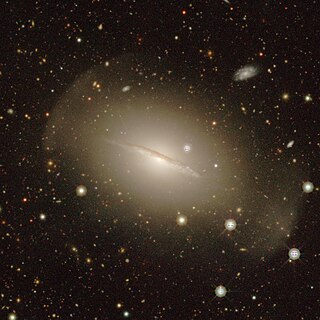
NGC 681 is an intermediate spiral galaxy in the constellation of Cetus, located approximately 66.5 million light-years from Earth.

NGC 2865 is an isolated elliptical galaxy in the equatorial constellation of Hydra. The core region of the galaxy shows a kinematically distinct component showing indications of a recent accretion or merger event that led to a burst of star formation around the nucleus. Observational constraints require this to have occurred within the last 100–400 million years, with the merger most likely being an Sb or Sc-class spiral galaxy.
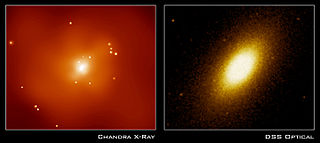
NGC 720 is an elliptical galaxy located in the constellation Cetus. It is located at a distance of circa 80 million light years from Earth, which, given its apparent dimensions, means that NGC 720 is about 110,000 light years across. It was discovered by William Herschel on October 3, 1785. The galaxy is included in the Herschel 400 Catalogue. It lies about three and a half degrees south and slightly east from zeta Ceti.




















